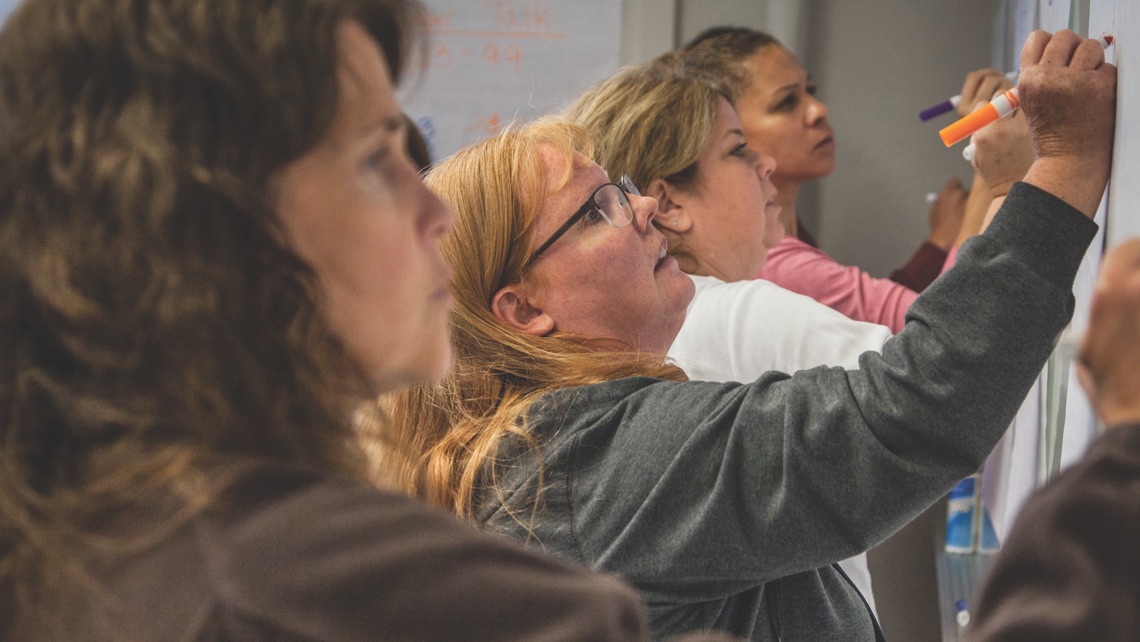Creating opportunities for educators, policymakers, and education advocates to engage directly in the close study of teaching practice
The TeachingWorks Elementary Mathematics Laboratory (EML) enables educators and education advocates to see the complex work of teaching in real time. Held from July 23 through August 3, 2018, the EML featured a two-week elementary mathematics class taught by TeachingWorks Director Deborah Loewenberg Ball and observed by participants as a part of the annual program hosted at the University of Michigan School of Education for local students in the Ypsilanti and Ann Arbor area. Now in its 15th year, the 2018 EML enrolled 21 rising fifth-grade students from Ypsilanti Community Schools, and brought together more than 80 teachers, teacher educators, district leaders, and policymakers from across the country.
TeachingWorks seeks to advance skillful teaching that disrupts patterns of inequities for children of color, and instead helps them to develop strong and positive academic identities. Each year, Ball designs her curriculum for the class to support students in developing skills in respectful argument and critical analysis, and attentive engagement with others’ ideas and thinking. Above all, she uses the class to show children the broad possibilities of mathematics and mathematical thinking.
“The instruction in the class is designed to create opportunities for highlighting the mathematical skills and knowledge the children already possess, while stretching their mathematical thinking, reasoning, and understanding,” Ball said.
The EML program is designed to provide participants an authentic, first-hand experience of designing and implementing lessons that incorporate the TeachingWorks high- leverage practices and specific teaching moves that can disrupt patterns of inequities in classrooms. Each morning before the class, EML participants worked with Ball and the instructional team in a “pre- brief” session in which they examined, discussed, and refined each day’s lesson plans and strategies for the instruction. They also worked in small groups to try out the mathematical problems and tasks the children would later complete, making note of specific responses from children and teaching moves from Ball they would analyze during the class.
Participants chose between observing the mathematics class in person or via live-stream from remote viewing rooms. In addition to the more than 80 teachers, teacher educators, and advocates that attended the 2018 EML in person, teachers in New York and the TeachingWorks Montgomery County Public Schools partnership attended the program via live-stream.
“I made many valuable connections with other participants in the program, and we still communicate with each other about the different strategies we learned during the EML and how we’re implementing and incorporating them in our work,” Denise Finney, 2018 EML Participant, San Diego, California
The unique laboratory setting of the class made visible the evolution of Ball’s teaching strategies and approaches in real time, and helped EML participants observe concrete ways of intertwining mathematical content with the high- leverage practices to position children of color as both valued members of the classroom and competent learners.
“Children bring new cultural, academic, and social knowledge with them to class every day,” Ball said. “The two-week- long laboratory class allows participants to see how teachers must draw on the rapidly changing contexts of their classroom from day to day to quickly adjust their instruction in ways that disrupt biases and stereotypes, and better support children.”
After each morning class, EML participants did a “gallery walk” of the classroom where they analyzed student work and made note of their responses to the mathematical tasks they completed in the morning. They then met again with the instructional team to debrief the day’s lesson, ask questions, and reflect on the teaching practices and strategies they observed.
“An important goal of the EML is to create a public conversation about teaching where we can think critically about the various nuances involved in instructional practice,” Ball said. “My goal is not for participants to think they’re seeing an expert teacher, but to inspire them to consider how skillful teaching is a strategy we can use to help children’s learning in this country improve.”
TeachingWorks prioritizes creating a high-quality, well-rounded experience for students enrolled in the Summer Mathematics Program. Each day after the morning class, students participated in afternoon fine arts programming at the University of Michigan Museum of Art, where they had a chance to explore historic artwork as well as create their own. They additionally received individual mentoring and support from students enrolled at the University of Michigan School of Education.
Also, in the afternoon during the first week of the program, EML attendees had the option of attending a variety of specially designed professional development sessions on facilitating mathematics discussions, examining children’s mathematical thinking, and learning strategies for instructional leadership through the high-leverage practices. The sessions were structured to emphasize key teaching moves participants observed in the morning laboratory class, and to help teacher educators and school administrators develop specific strategies for coaching and supporting beginning teachers.
Denise Finney, math and science coordinator for Chula Vista Elementary School District in San Diego, California, participated in the professional development session focused on instructional leadership. Within a week of the program, she said she shared many of the tools and strategies she learned for observing and giving feedback to teachers with several principals and district administrators. Above all, she said she valued the opportunity the EML provided for collaborating with other mentor and practicing teachers outside of her district.
“The vulnerability of the instructional team and the openness of the professional development leaders made me feel such a strong sense of community,” Finney said. “I made many valuable connections with other participants in the program, and we still communicate with each other about the different strategies we learned during the EML and how we’re implementing and incorporating them in our work.”



